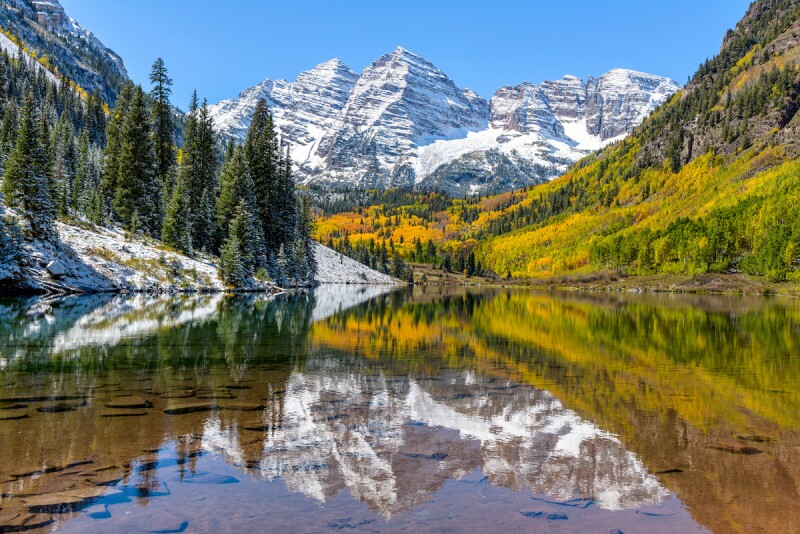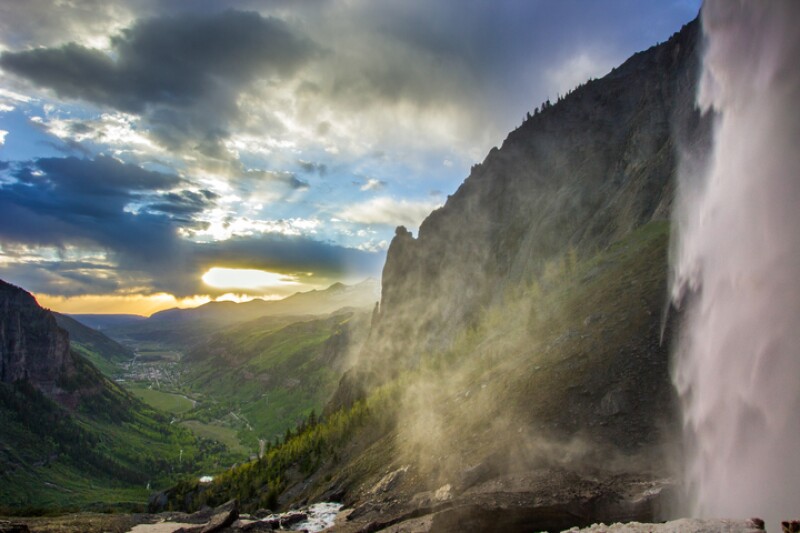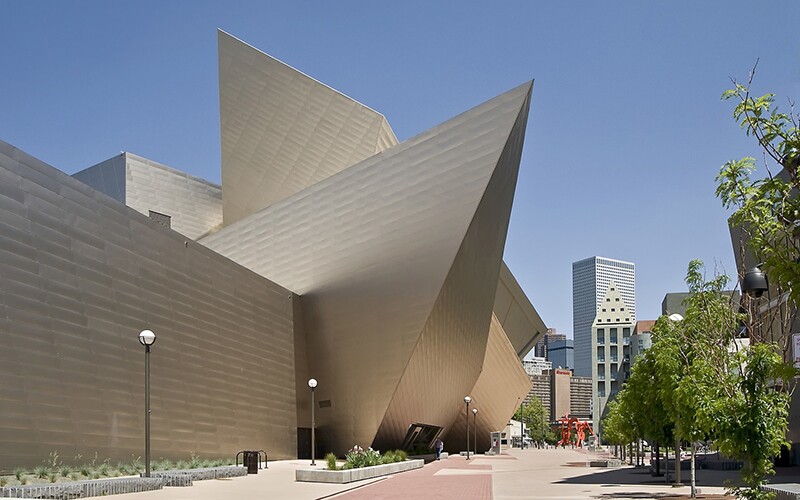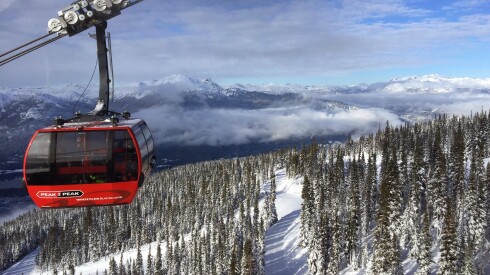Colorado has long enjoyed a reputation as one of the United States’ great adventure capitals, with four-season thrills that include white-water rafting through a historic mining valley, skiing hut to hut in the backcountry, or hiking among ancient archaeological sites in a national park. But it’s also a place filled with history and culture, where you can listen to live music in a red-rock amphitheater, dine in Michelin-starred restaurants, and visit stellar museums.
The easy spirit invoked by John Denver’s “Rocky Mountain High” is alive and well here, whether you visit the peaceful park in Aspen that’s dedicated to his memory or summiting one of the 53 peaks above 14,000 feet that so inspired him. Below are even more ideas for making the most of your time in the Centennial State.
Hike to the glaciers in Rocky Mountain National Park
Whether you opt to hike, bike, or drive at your leisure through Rocky Mountain National Park, take Trail Ridge Road for the best photo ops and scenic views. Start your exploration in the montane ecosystem, where lush trees, shrubs, and flowers provide a habitat for moose, bears, badgers, and a wide range of birds. From there, you’ll ascend to the subalpine section of the park—an area full of firs, pines, elk, mountain lions, and coyotes. Next comes the alpine tundra layer, known as the “land above the trees.” Here, you’ll spot lichens and wildflowers and smaller mammals like marmots and pikas. Finally, you’ll reach the glacier layer, where you can get up close and personal with elk in the fresh snow (even in the summertime). The entire journey is an amazing opportunity to experience how the layers of forest have grown and adapted to their surroundings over time, providing life for the many animals that call Rocky Mountain National Park home.
Go on a Michelin-starred restaurant crawl across the state

Bosq was the only restaurant in Aspen to earn a star in Colorado’s first Michelin Guide.
Courtesy of Bosq
Colorado’s food scene has been steadily on the rise for at least a decade, with the state hosting the 15th season of Top Chef and making a strong showing at the James Beard Awards. Last year, its culinary status was cemented when it became the newest location in the United States to get its own Michelin Guide. For the first edition, five restaurants earned one star, including a trio in Denver: Beckon, where guests dine on an eight-course tasting menu that changes every three months; the Wolf’s Tailor, which has a zero-waste approach and a menu that draws on Nordic, Italian, and East Asian influences; and Brutø, a modern Mexican spot, where popular Top Chef contestant Byron Gomez recently took over as chef. Beyond the capital, check out Boulder’s beloved neighborhood restaurant Frasca Food and Wine, which celebrates its 20th birthday in 2024 and is dedicated to the flavors of northeast Italy’s subalpine region Friuli–Venezia Giulia. In Aspen, Bosq is all about sustainable, biodynamic, wild-foraged ingredients, with a menu that includes lobster grilled over juniper branches and bison oxtail mole.
Take a drive down the Peak to Peak Scenic Byway

The impressive Chapel on the Rock is one of many worthy stops along the Peak to Peak Scenic Byway.
Courtesy of agefotostock
The 55-mile Peak to Peak Highway may be only 55 miles, but it will take you between three and four hours to drive from end to end because you won’t be able to resist all the appealing stops along the way. Colorado’s oldest scenic byway was built in 1918, and it runs from Estes Park to Interstate 70, in a path roughly parallel to the Continental Divide—the ridge line that divides the Pacific watershed from that of the Atlantic. Lining the road are hiking trails, mountain lakes, campgrounds, ghost towns, old gold mines, and the landmark Chapel on the Rock, which was constructed in 1935 and later visited by Pope John Paul II. During the fall months, drivers can expect to find stunning yellow foliage, especially just north of the town of Nederland. The state of Colorado is in the process of “electrifying” its scenic and historic byways, which involves installing fast-charging stations for electric vehicles, offering a new, eco-friendly way to take in the scenery.
Catch a show at Red Rocks Park and Amphitheatre

Even when there isn’t a concert happening, Red Rocks Amphitheatre is a popular spot for people to do yoga or run up and down the stairs.
Photo by Jay Yuan/Shutterstock
About 20 minutes west of downtown Denver, Red Rocks Park and Amphitheatre is one of the most acoustically perfect, naturally occurring arenas in the world. Since it first opened in 1941, it’s hosted a wide range of iconic musical performances, from opera and rock to electronic and folk, as well as the “Film on the Rocks” series in the summer. The stage is flanked by two 300-foot orange sandstone monoliths that rise like sails against the sky. During the day, fitness junkies run up and down the 69 rows of seats. If this is a feat you’d like to tackle, pace yourself—you’ll be working out at 6,450 feet above sea level. Nearby are hiking and biking trails that allow you to discover the flora and fauna in this uniquely situated park at the meeting point of the Great Plains and the Rocky Mountains.
Go white-water rafting down the Clear Creek

Chase rapids on a rafting adventure on the Clear Creek.
Photo by Charles A. Blakeslee/agefotostock
Colorado has more than its fair share of prime white-water rafting, but the stretch of Clear Creek at Idaho Springs, 35 miles from downtown Denver, has more thrills per mile than just about any other river in the state. Running through a historic mining valley, Clear Creek is the steepest commercially rafted river in Colorado, meaning you won’t find many flat stretches in between rapids. Several rafting companies operate here, with trip offerings that range from morning beginner runs to full-day advanced adventures. No matter which you choose, if you can take your eyes off the churning water for a second, you just might spot a bighorn sheep or even a bear or mountain lion on the banks of the river.
Honor a legendary musician at the John Denver Sanctuary

Feel that Rocky Mountain high at the John Denver Sanctuary in Aspen.
Photo by Dr. Alan Lipkin/Shutterstock
Pay your respects to the man who penned “Rocky Mountain High” and spent much of his time in Colorado when you visit the John Denver Sanctuary, a cluster of carved boulders and monuments located just off the Rio Grande Trail in Aspen. Here, you’ll find some of the singer’s most famous lyrics carved into the stones lining the Roaring Fork River. For an extra special experience, join the fans who gather at the site every October 12, the anniversary of John Denver’s death, to collect their thoughts and pay homage to the great American songwriter.
Take a soak at Iron Mountain Hot Springs

The pools at Iron Mountain Hot Springs make for an ideal pit stop on a cross-state road trip.
Courtesy of Iron Mountain Hot Springs
Visitors to Iron Mountain Hot Springs in Glenwood Springs will be delighted to find 16 small thermal pools on the banks of the Colorado River, plus a large freshwater pool heated to 94 degrees, a sundeck, and a casual café. The smaller pools contain a variety of minerals and are kept at a range of temperatures, inviting guests to spend the day hopping between them in pursuit of relaxation. Last year, Iron Mountain expanded with a new section called WorldSprings, which is something like Disney’s Epcot of hot springs: Each of its 11 adults-only pools is inspired by a famous hot spring around the world, such as Soda Springs in New Zealand, Osaek Hot Springs in South Korea, and the Blue Lagoon in Iceland. The pools inspire such a sense of calm that you’ll barely notice the entire property borders the shoulder of I-70. The location is actually a boon, as it means Iron Mountain is the perfect stopover on cross-state road trips. Or you could embark on the full, 800-mile Colorado Historic Hot Springs Loop, which connects 23 aquatic centers, hot pots, terraced pools, and travertine formations around the state.
Explore the backcountry through the 10th Mountain Division Hut Association

Witness extraordinary scenery on a hut-to-hut hike in the Colorado backcountry.
Photo by Ed Ogle/10th Mountain Division Hut Association
During World War II, hundreds of U.S. soldiers trained in the mountains of Colorado to prepare for wintry battles in the Alps. Many fell so in love with the area that they returned after the war to help develop a system of mountain huts that now offers some of the best ski touring in North America. Today, the 38 huts in the 10th Mountain Division Hut Association provide unrivaled access to Colorado’s backcountry and 350 miles of suggested routes. They book up almost a year in advance, but if you’re lucky enough to get a reservation, you’ll be in for a once-in-a-lifetime experience of pristine terrain, stunning sunsets, and memorable proximity to 14,000-foot peaks. Each hut has room for between 3 and 20 people, and most are at least a seven-mile hike from the trail, but guests are rewarded with the satisfaction of hiking through gorgeous terrain, living simply, and getting to know the Colorado mountains.
In 2022, President Joe Biden proclaimed Camp Hale—where the 10th Mountain Division trained—to be a 53,804-acre national monument, about 30 minutes south of Vail. By winter, you can go Nordic skiing or snowmobiling, while summer brings ATV rides and hiking, and many experiences can be booked through the Lodge at Camp Hale.
Brush up on geology in Garden of the Gods

Garden of the Gods is home to stunning geological formations like Kissing Camels and Balancing Rock.
Photo by Sean Pavone/Shutterstock
Located on the west side of Colorado Springs, at the foot of Pikes Peak, Garden of the Gods is a geological wonderland prime for hiking, biking, or even rock climbing. The towering formations of red sandstone are the stubborn remnants of massive sand dunes that eroded after an inland sea retreated millions of years ago. The area is easily accessed from I-25 and, if you choose to, you can drive through the park via a quick loop (but avoid this on the weekends during peak tourist season when lines can be long). Don’t forget your camera; you’ll want to get a shot at the world-famous Balancing Rock, a chunk of red sandstone that looks as if it could tumble from its perch any second. Before heading home, stop at the visitor center for a fine view of the Kissing Camels rock formation.
Sleep under the stars in Black Canyon of the Gunnison National Park

A Dark Sky Park, Black Canyon offers unmatched stargazing.
Photo by Corlaffra/Shutterstock
Described by the National Park Service as “a vertical wilderness of rock, water, and sky,” Black Canyon of the Gunnison is home to some of the steepest cliffs, oldest rocks, and most jagged spires in North America. It’s also a designated International Dark Sky Park, meaning the stargazing is exceptional. Many visitors from nearby Montrose come here for the day to hike, kayak, fish for trout, and more, but the truly adventurous choose to stay overnight at one of three campgrounds. The most accessible, family-friendly choice, South Rim Campground, is near the Night Sky Viewing and Telescope site as well as the amphitheater where ranger programs take place. For something more remote, try North Rim, where campsites are spacious and spread out among piñon and juniper trees, or East Portal, which is located at the bottom of the canyon along the Gunnison River.
Get out on the water at Alta Lakes

Go paddleboarding against a picturesque backdrop at Alta Lakes.
Courtesy of Visit Telluride
Six miles from downtown Telluride and accessible by high-clearance 4x4 vehicles, Alta Lakes is a sonnet-worthy area of crystal-clear alpine lakes, studded on all sides by snow-capped peaks. Camping is primitive—don’t expect running water, much less a hot shower—but it’s precisely these rustic conditions that keep the surroundings so pure. Area residents love Alta for its hiking and mountain biking trails and because it looks like an Instagram post come to life. When you’re done exploring in nature, be sure to stop by the hamlet of Alta, a former mining boomtown straight out of a spaghetti western.
Snap a photo of the Maroon Bells

The Maroon Bells get their signature color from the weathering of iron-rich hematite stone.
Photo by Sean Xu/Shutterstock
Ten miles west of Aspen, the peaks known as the Maroon Bells are touted as the most photographed place in Colorado—and perhaps the most photographed mountains in the United States. Visitors flock to the natural landmark to snap a picture of the two giant snow-capped mountains (Maroon Peak and North Maroon Peak) reflected in a turquoise lake and, depending on the season, surrounded by either wildflowers or golden aspens. To explore the site for yourself, rent a bike in town at Hub of Aspen, and be sure to bring a water bottle and some snacks for energy. The mostly uphill 11-mile ride from downtown will have your quads and lungs burning—you’ll gain about 1,630 feet of elevation along the way—but the views at the top will be well worth the effort. You could always opt for an electric bike for an easier climb.
Discover breathtaking nature at Bridal Veil Falls

The largest waterfall in Colorado, Bridal Veil is a site to behold.
Courtesy of Visit Telluride
Misty waterfalls are like unicorns in the landlocked, high-and-dry state of Colorado. Bridal Veil is a dead ringer for its namesake: a mist, as delicate as nuptial lace, kicked up by water cascading over and down sheer vertical cliffs. At 365 feet high, the falls also happens to be the tallest free-falling waterfall in Colorado. For a prime view, say “I do!” to the 1.8-mile hike to the top, where a historic power plant overlooks the evergreen-studded landscape, or rent a bike in nearby Telluride to explore the car-free trails in Bridal Veil basin.
Get cultured at the Denver Art Museum

The Denver Art Museum houses an extensive collection of American Indian art.
Photo by Jürgen Gregor/agefotostock
With more than 70,000 works of art, the Denver Art Museum requires several visits to fully appreciate its collections. Founded in 1949, the museum is primarily known for its extensive collection of American Indian art, but also features Asian, pre-Columbian, and western American works, among many other styles. The Civic Center cultural institution sprawls across two main buildings, both by significant architects. The Martin Building was designed by Italian modernist architect Gio Ponti and opened in 1971. It’s one of the first “high-rise” art museums in the world, shaped like an imposing, eight-story fortress, and it reopened in 2021 after an extensive renovation project. Next door sits Daniel Libeskind’s Hamilton Building, which is inspired by the jagged, geometric shapes of the Rockies.
If you have extra time, head down the street to the Clyfford Still Museum, one of the finest single-artist collections in the country. The cantilevered concrete space, which lets in abundant soft sunlight through its perforated ceiling, is home to more than 90 percent of the artworks created by the abstract expressionist legend. Even if you don’t think you know or like Still’s work before you enter, you’ll be a fan by the time you leave.
Hitch a ride on the Durango & Silverton Narrow Gauge Railroad

Take a scenic trip on a vintage steam train through the San Juan Mountains.
Photo by Joshua Berman
This 45.4-mile narrow-gauge railroad track was built in 1882 to haul silver and gold ore through the San Juan Mountains, but it quickly became popular with passengers for its stunning views. To this day, the line offers mountain vistas that are inaccessible by highway, making a ride from Durango to Silverton more than worth your time. Guests board a vintage steam locomotive in the morning at the depot in Durango, just as they did back in the 19th century, and find themselves in Silverton 3.5 hours later. Then they can ride the same train back or, as a quicker alternate return route, opt for a one-hour bus ride down Highway 550. There are a number of cars and classes to choose from when booking, from standard coach to Knight Sky, an all-glass carriage in first class that allows for views up into the canyons.
Go back in time at Mesa Verde National Park

Explore ancient Pueblo architecture in Mesa Verde National Park.
Courtesy of NPS Photo
For anyone who thinks that ancient architecture doesn’t exist in the USA, Mesa Verde National Park will make you think again. Still standing in the park are cliff dwellings built in 600 C.E. by the ancestral Pueblo people who once lived in the area. A transformative day trip, Mesa Verde is nearly two hours from Telluride but well worth the drive to explore its 5,000 archeological sites, from Cliff Palace (a ranger will guide you on the hike up, which involves climbing 10-foot ladders) to Balcony House (which you’ll enter via a 12-foot tunnel).
For one of the coolest stays nearby, book a night or two at the Canyon of the Ancients Guest Ranch, 40 minutes from the national park in McElmo Canyon, out near Four Corners. The friendly owners, Garry and Ming Adams, are obsessive about exploring their surroundings, and they’ve personally discovered ancient dwelling sites and incredible rock art (hand prints and petroglyphs) hidden among the area’s mesas and sandstone cliffs; they’ll be happy to point you in the right direction for self-guided exploration or take you out on a tour themselves. In addition to the ranch’s collection of cabins and houses, which sleep between two and eight, they recently added two new lodging options, the Star Tower and Sky Kiva at Sky Village, which draw on Native American architecture and design and offer incredible stargazing opportunities.
Hit the slopes at Snowmass and more

Snowmass has a trail for every ability of skier, sprawling across more than 3,000 acres of varied terrain.
Photo by Lana G/Shutterstock
A winter trip to Colorado usually means skiing, but it can be hard to choose a destination with so many top-notch mountains on offer. For some of the most diverse terrain, head to Snowmass just outside of Aspen. The largest of Aspen Skiing Company’s four mountains, it offers something for everyone, plus a ski school for everyone from two year olds to adults.
For something closer to Denver, try Eldora Mountain; it’s so close, in fact, that it even has a run named City Lights because you can see the skyline from the top of trail in the evenings. If you’re staying in Boulder instead, know that an RTD bus connection (the “N” route for Nederland) runs seven times a day, shuttling skiers between the Boulder Transit Center and the base of Eldora in as few as 45 minutes, stopping 40 feet from the main lift. Otherwise, it’s an easy 20-mile drive up Boulder Canyon.
If you want to get away from the crowds, opt for Telluride Ski Resort, where you’ll find blissfully short lift lines, some of the freshest powder in the state, and terrain for every ability, from bunny hills for beginners to double-black-diamond glades for the pros. Don’t be surprised if you have a run all to your lonesome or get a record stretch of bluebird days—Telluride has 300 days of sunshine a year.
Joshua Berman, Jen Murphy, and Holly Upper contributed to the reporting of this story. This article originally appeared online in 2020; it was most recently updated on February 23, 2024, to include current information.











